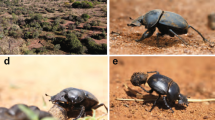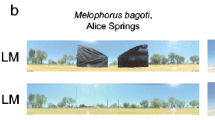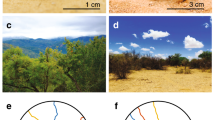Abstract
When hoarding food under infra-red light, golden hamsters Mesocricetus auratus W. return fairly directly from a feeding place to their nest site by evaluating and updating internal signals that they have generated during the previous outward journey to the feeding place. To test more specifically the animals' capacity to evaluate the linear components of the outward journey, the subjects were led from their (cone-shaped) nest to a feeding place along a detour which comprised either 2 (experiment 1) or 5 (experiment 2) segments; adjoining segments were at right angles to each other. In these conditions, the subjects remained significantly oriented towards the nest and therefore were capable of assessing translations as well as rotations during the outward journey. In experiment 3, the nest was removed after the hamsters had started the direct outward journey to the feeding place and the hamsters were rotated during the food uptake. The animals were no longer oriented towards the starting point of their journey, but nonetheless covered, along a fairly straight path, the correct homing distance, and then changed over to a circular search path. These results confirm that mammals can derive the linear components of an outward journey from self-generated signals and therefore are able to judge the homing distance without relying on cues from the environment. For a number of detour outward journeys, our data yield an unexpectedly good fit to Müller and Wehner's (1988) model of dead reckoning in ants. However, this is no longer the case when the outward journey contains an initial loop which brings the subject back to the starting point. These findings are discussed in terms of the biological significance and limitations of an approximate form of path integration.
Similar content being viewed by others
References
Batschelet E (1981) Circular statistics in biology. Academic Press, London
Benhamou S, Sauvé JP, Bovet P (1990) Spatial memory in large scale movements: efficiency and limitation of the egocentric coding process. J Theor Biol 145:1–12
Berthoz A, Israël I, Vitte E, Zee D (1988) Linear displacement can be derived from otolithic information and stored on spatial maps controlling the saccadic system. Adv Oto-Rhino-Laryngol 41:76–81
Bisetzky AR (1957) Die Tänze der Bienen nach einem Fussweg zum Futterplatz. Z Vergl Physiol 40:264–288
Blest AD (1960) The evolution, ontogeny and quantitative control of the settling movements of some New World Saturniid moths, with some comments on distance communication by honey bees. Behaviour 16:188–253
Bovet J (1984) Strategies of homing behavior in the red squirrel, Tamiasciurus hudsonicus. Behav Ecol Sociobiol 16:81–88
Dornfeldt K (1975) Eine Elementaranalyse des Wirkungsgefüges des Heimfindevermögens der Trichterspinne Agelena labyrinthica (Cl.). Z Tierpsychol 38:267–293
Duelli P (1976) Distanzdressuren von getragenen Ameisen, Cataglyphis bicolor Fabr. (Hymenoptera: Formicidae). Rev Suisse Zool 83:413–418
Etienne AS (1978) Energy versus time dependent parameters in the determination of a behavioural sequence in the Aeschna larva. J Comp Physiol 127:89–96
Etienne AS (1980) The orientation of the golden hamster to its nest-site after the elimination of various sensory cues. Experientia 36:1048–1050
Etienne AS, Maurer R, Portenier V, Saucy F, Teroni E (1986a) Short-distance homing of the golden hamster under conditions of darkness and light. In: Beugnon G (ed) Orientation in space. Privat, IEC, Toulouse
Etienne AS, Maurer R, Saucy F, Teroni E (1986b) Short-distance homing in the golden hamster after a passive outward journey. Anim Behav 34:696–715
Etienne AS, Maurer R, Saucy F (1988) Limitations in the assessment of path dependent information. Behaviour 106 1/2:81–111
Frisch K von (1965) Tanzsprache und Orientierung der Bienen. Springer, Berlin Heidelberg New York
Gallistel CR (1980) The organization of action: A new synthesis. Erlbaum, Hillsdale NJ
Gallistel CR (1990) The organization of learning. MIT Press, Cambridge London
Görner P, Claas B (1985) Homing behavior and orientation in the funnel-web spider, Agelena labyrinthica Clerck. In: Barth F (ed) Neurobiology of arachnids. Springer, Berlin Heidelberg New York
Hill DE (1979) Orientation by jumping spiders of the genus Phidippus (Araneae: Salticidae) during the pursuit of prey. Behav Ecol Sociobiol 5:301–322
Hoffmann G (1984a) Homing by systematic search. In: Varjú D, Schnitzler HU (eds) Localization and orientation in biology and engineering. Springer, Berlin Heidelberg New York
Hoffmann G (1984b) Orientation behaviour of the desert woodlouse Hemilepistus reaumuri: adaptation to ecological and physiological problems. Symp Zool Soc Lond 53:405–422
Israël I, Berthoz A (1989) Contribution of the otoliths to the calculation of linear displacement. J Neurophysiol 62:247–263
Maurer R (1993) L'intégration du chemin ou navigation à l'estime chez les êtres vivants: formalisation de modèles neuromimétiques. Unpubl Doct Disser, University of Geneva, Switzerland
Mayne R (1974) A systems concept of the vestibular organs. In: Kornhuber HH (ed) Handbook of sensory physiology Vol. VI/II. Springer, Berlin Heidelberg New York
Miller S, Potegal M, Abraham L (1983) Vestibular involvement in a passive transport and return task. Physiol Psychol 11:1–10
Mittelstaedt H (1978) Kybernetische Analyse von Orientierungsleistungen. In: Kybernetik 1977. Oldenbeurg, München Wien
Mittelstaedt H, Mittelstaedt ML (1982) Homing by path integration. In: Papi F, Wallraff HG (eds) Avian navigation. Springer, Berlin Heidelberg
Mittelstaedt ML, Glasauer S (1991) Idiothetic navigation in gerbils and humans. Zool Jb Physiol 95:427–435
Müller M, Wehner R (1988) Path integration in desert ants, Cataglyphis fortis. Proc Natl Acad Sci USA 85:5287–5290
O'Keefe J, Nadel L (1978) The hippocampus as a cognitive map. Clarendon Press, Oxford
Potegal M (1982) Vestibular and neostriatal contributions to spatial orientation. In: Potegal M (ed) Spatial abilities. (Development and physiological foundations). Academic Press, New York, pp 361–387
Saint Paul U von (1982) Do geese use path integration for walking home? In: Papi F, Wallraff HG (eds) Avian navigation. Springer, Berlin Heidelberg, pp 299–307
Sauvé JP (1989) L'orientation spatiale: formalisation d'un modèle de mémorisation égocentré et expérimentation chez l'homme. Unpubl Doct Dissert, University of Aix-Marseille II
Seyfarth E-A, Hergenröder R Ebbes H, Barth FG (1982) Idiothetic orientation of a wandering spider: compensation of detours and estimates of goal distance. Behav Ecol Sociobiol 11:139–148
Teroni E, Portenier V, Etienne AS (1987) Spatial orientation of the golden hamster in conditions of conflicting location-based and route-based information. Behav Ecol Sociobiol 20:389–397
Teroni E, Portenier V, Etienne AS (1990) Utilisation par le hamster doré d'indices visuels dans un environnement visuellement symétrique. Biology of Behaviour 15:74–92
Wehner R (1982) Himmelsnavigation bei Insekten. Neurophysiologie und Verhalten. Neujahrsblatt der Naturforschenden Gesellschaft Zürich 184:1–132
Wehner R, Srinivasan MV (1981) Searching behaviour of desert ants, genus Cataglyphis (Formicidae, Hymenoptera). J Comp Physiol 142:315–338
Wehner R, Wehner S (1986) Path integration in desert ants: Approaching a long-standing puzzle in insect navigation. Monit Zool Ital 20:309–331
Author information
Authors and Affiliations
Rights and permissions
About this article
Cite this article
Séguinot, V., Maurer, R. & Etienne, A.S. Dead reckoning in a small mammal: the evaluation of distance. J Comp Physiol A 173, 103–113 (1993). https://doi.org/10.1007/BF00209622
Accepted:
Issue Date:
DOI: https://doi.org/10.1007/BF00209622




